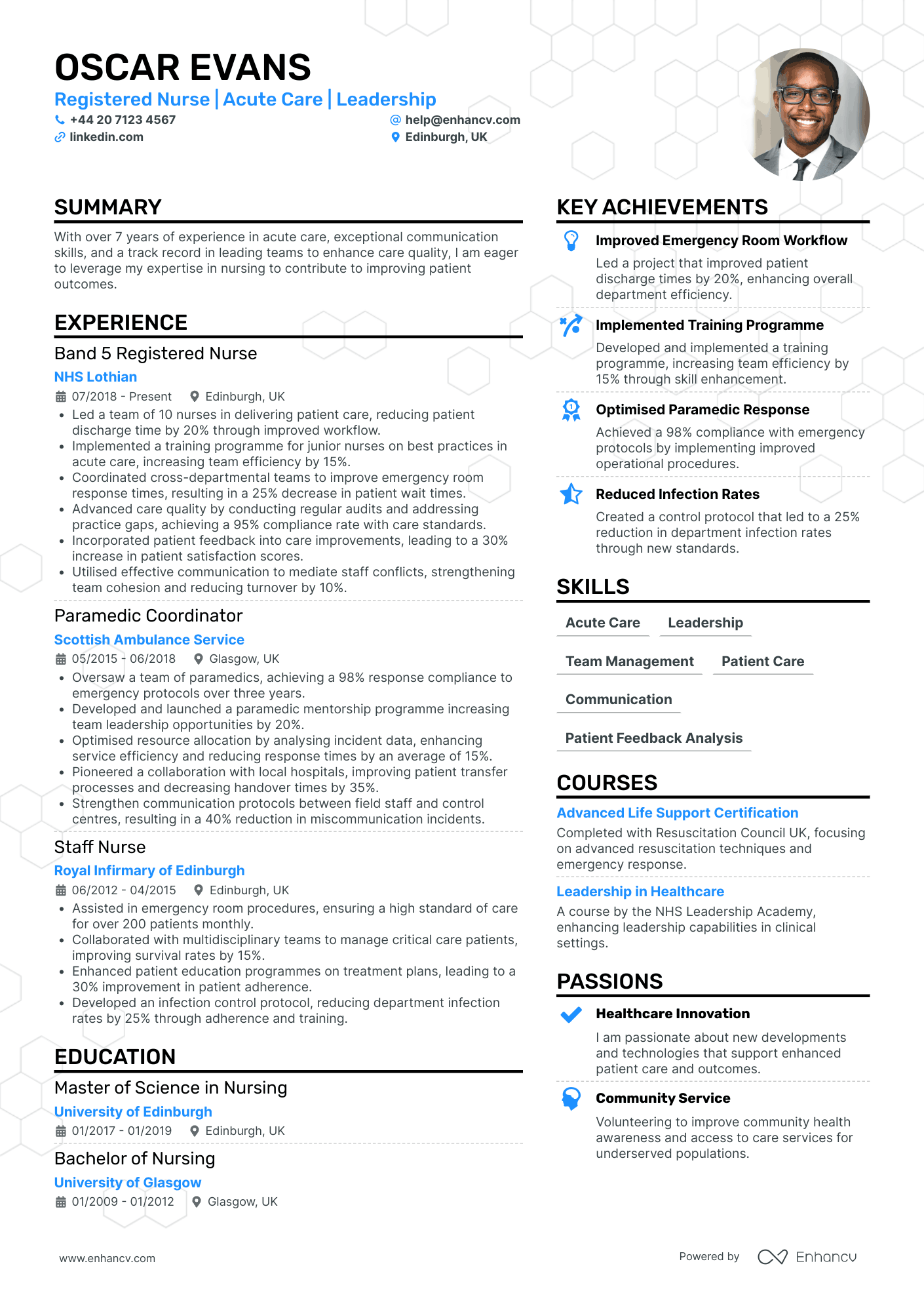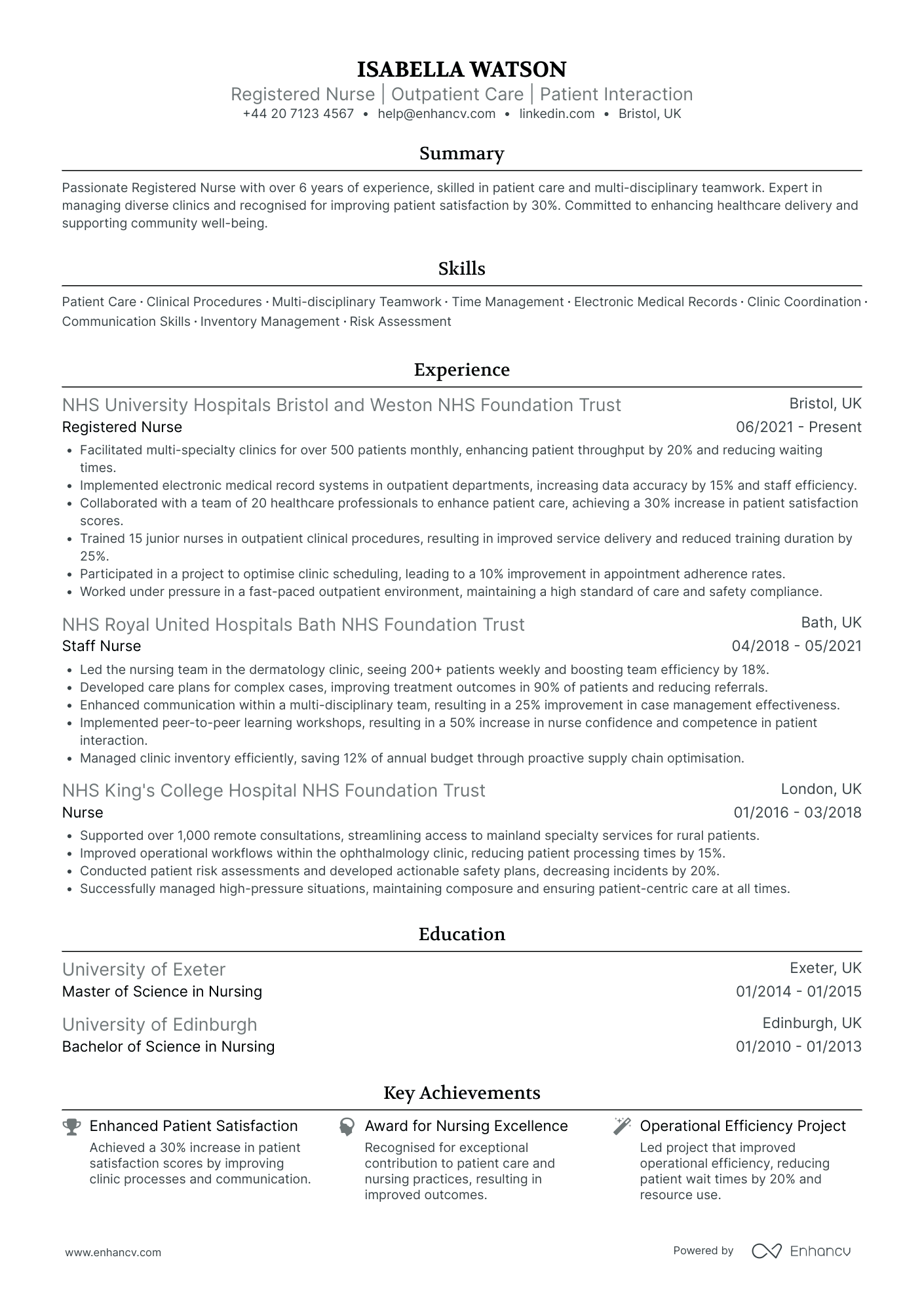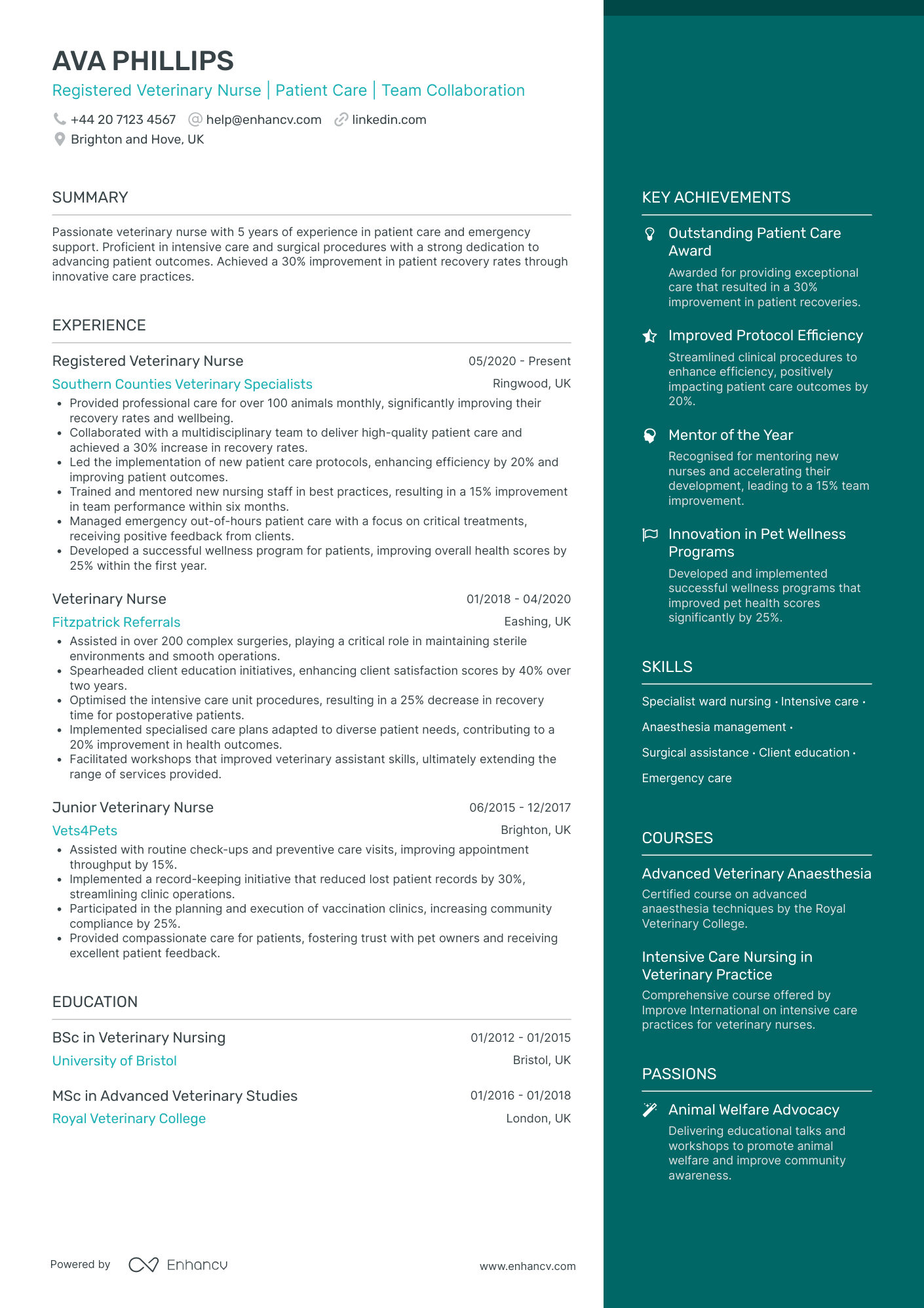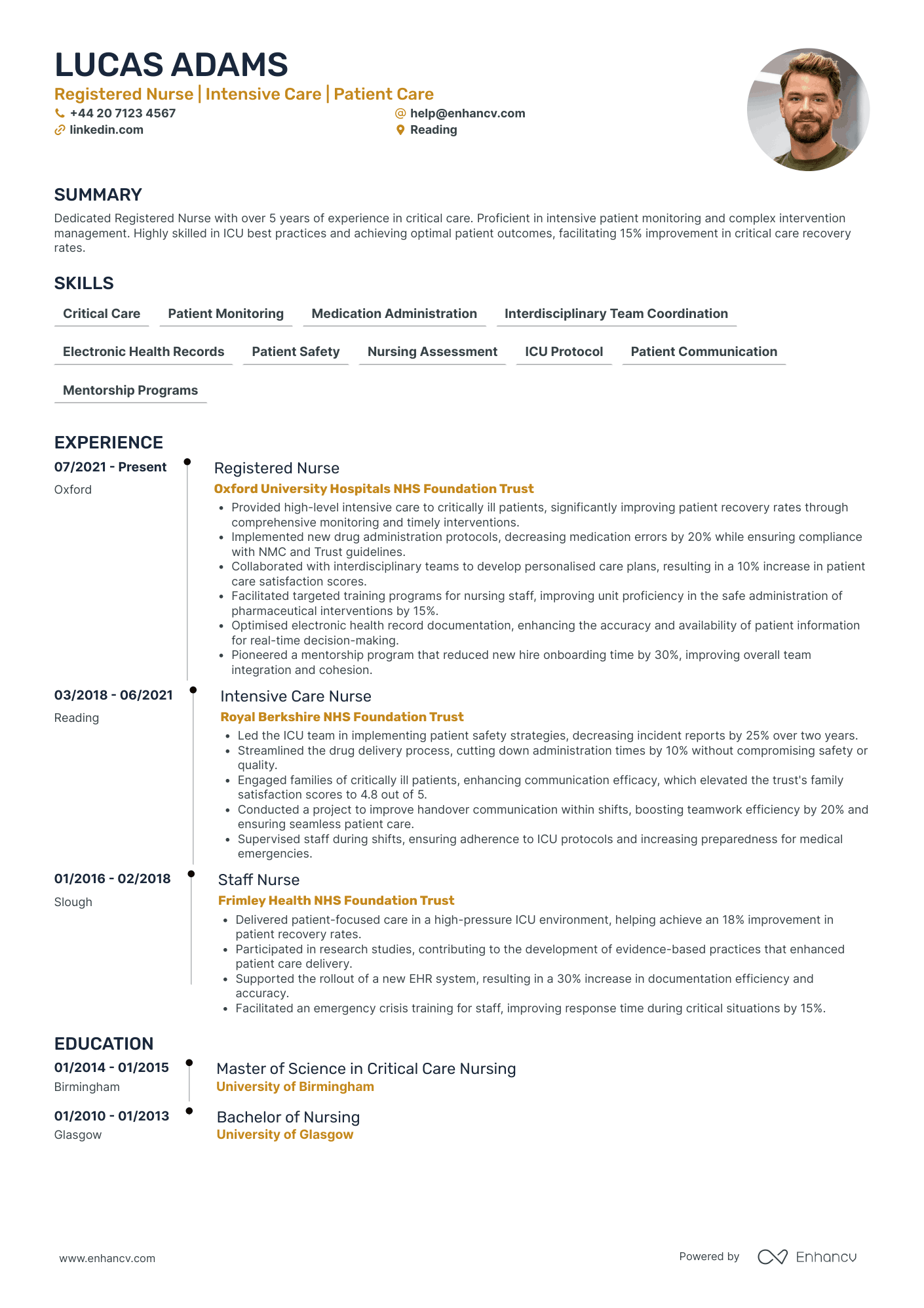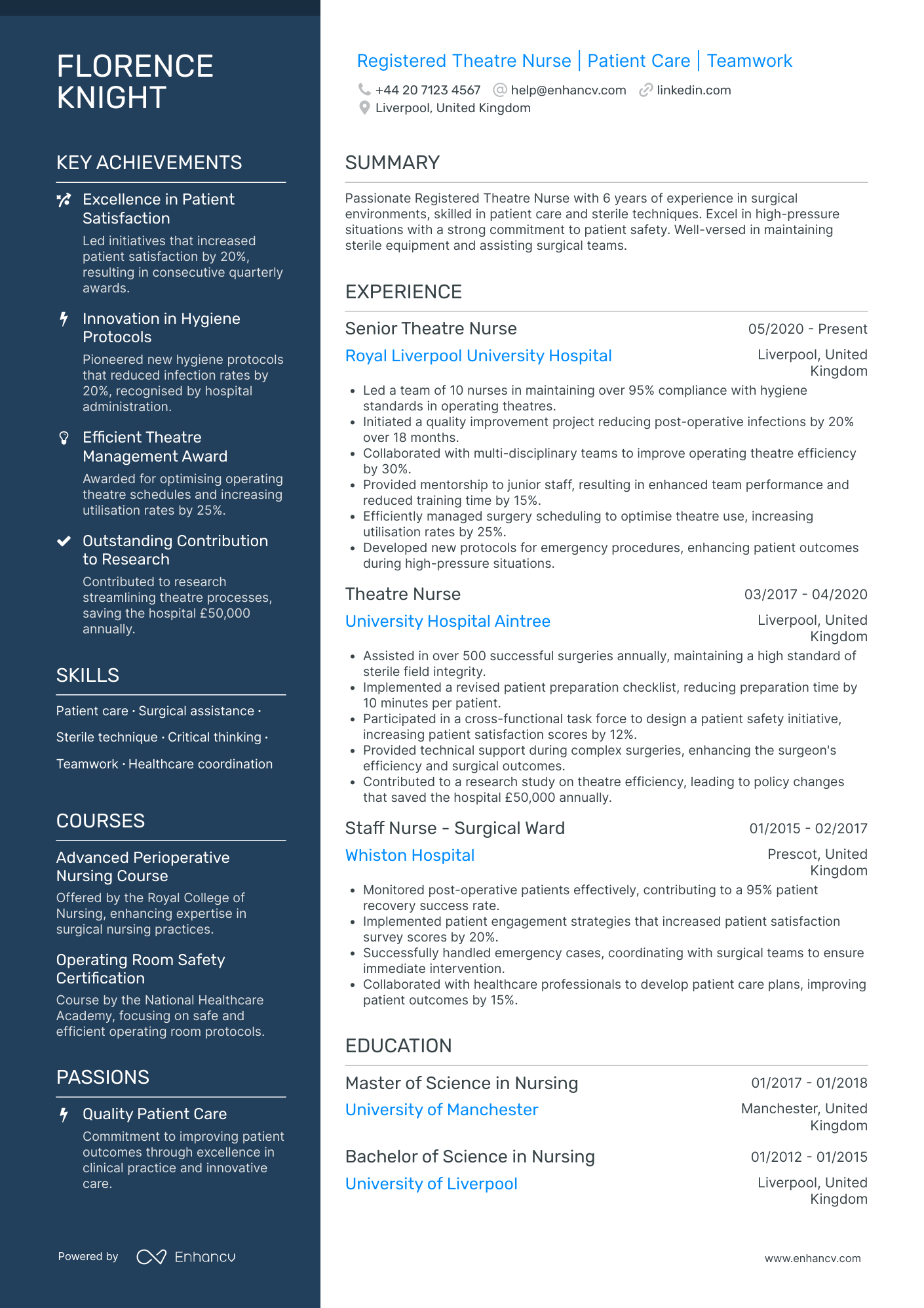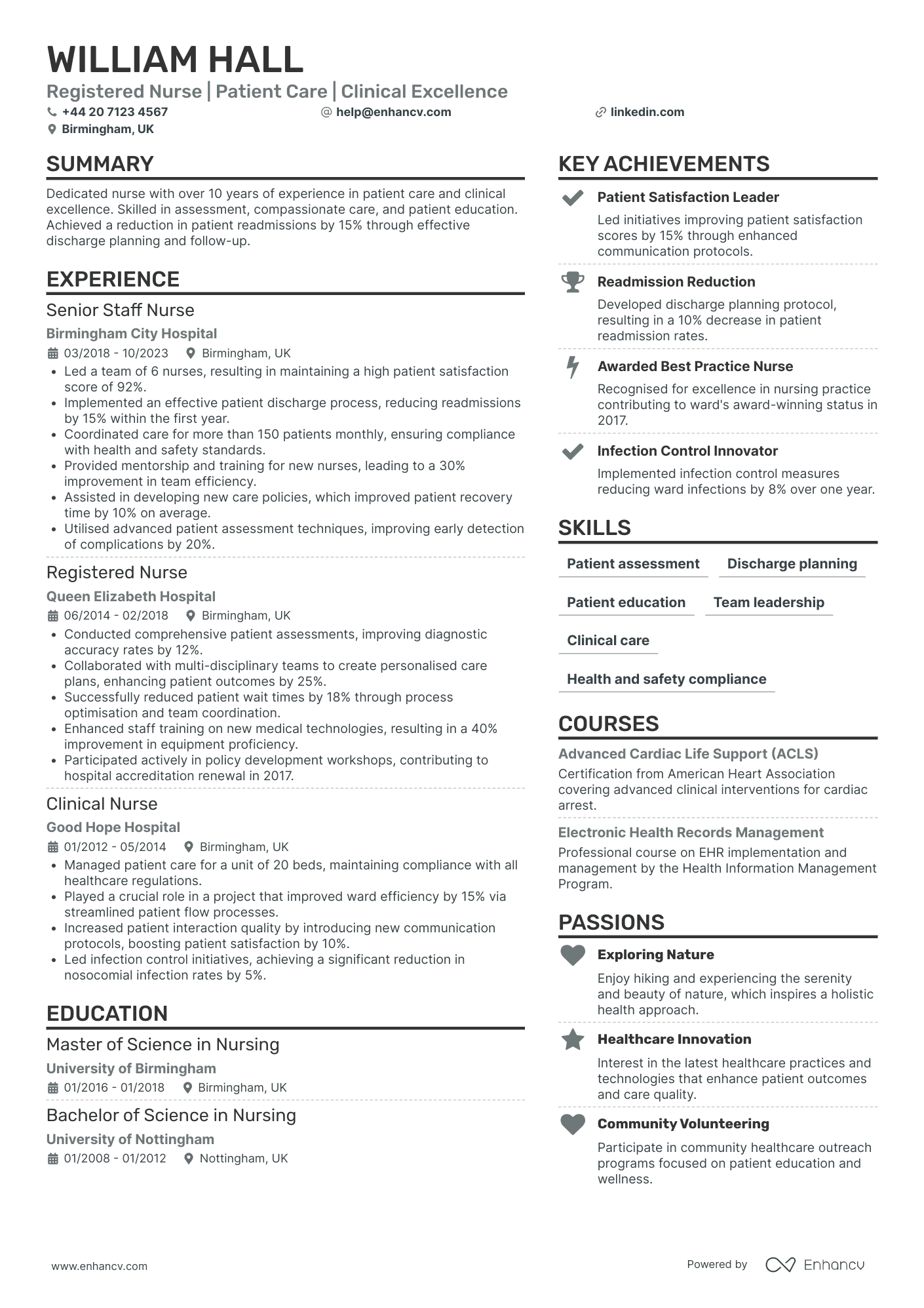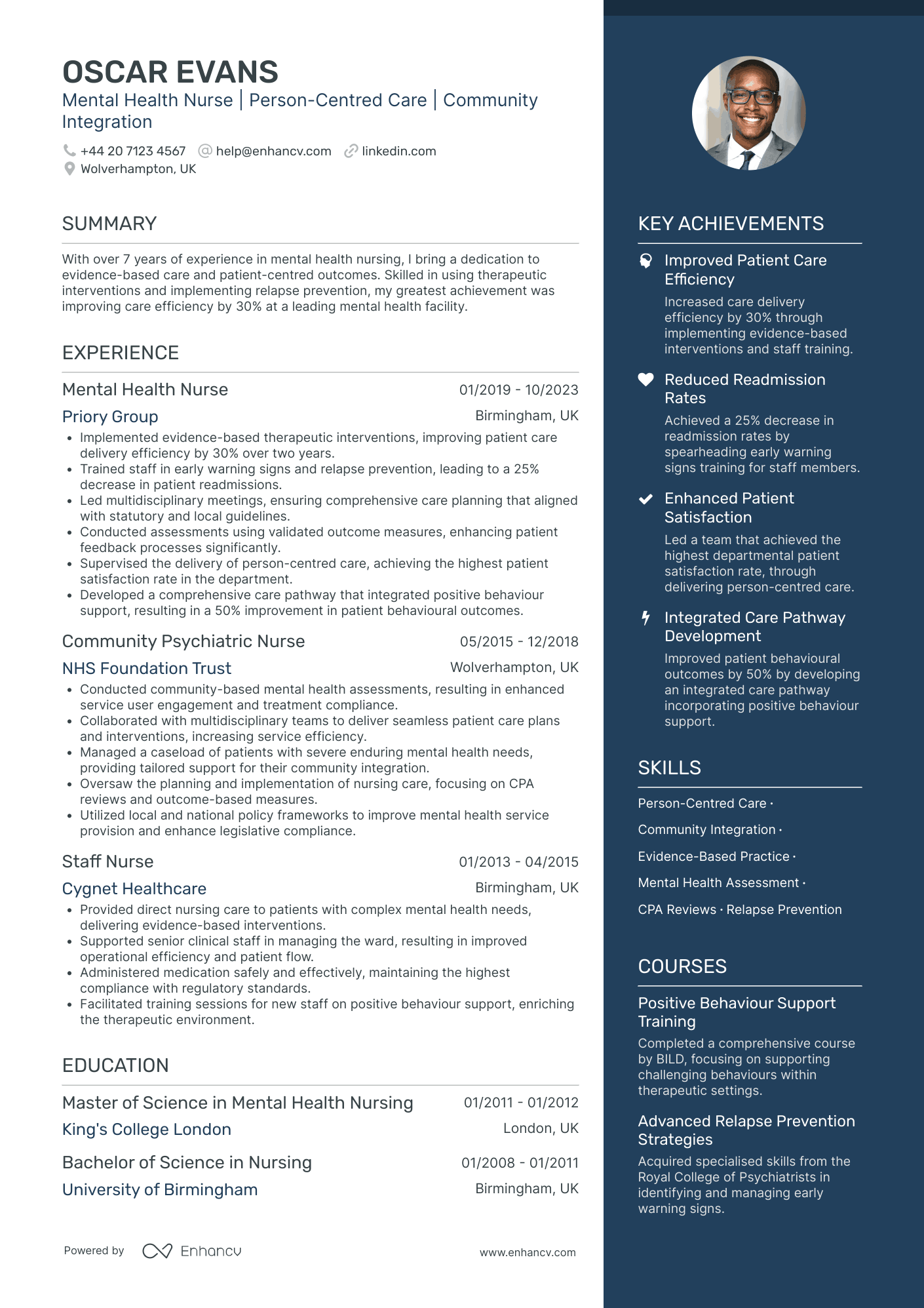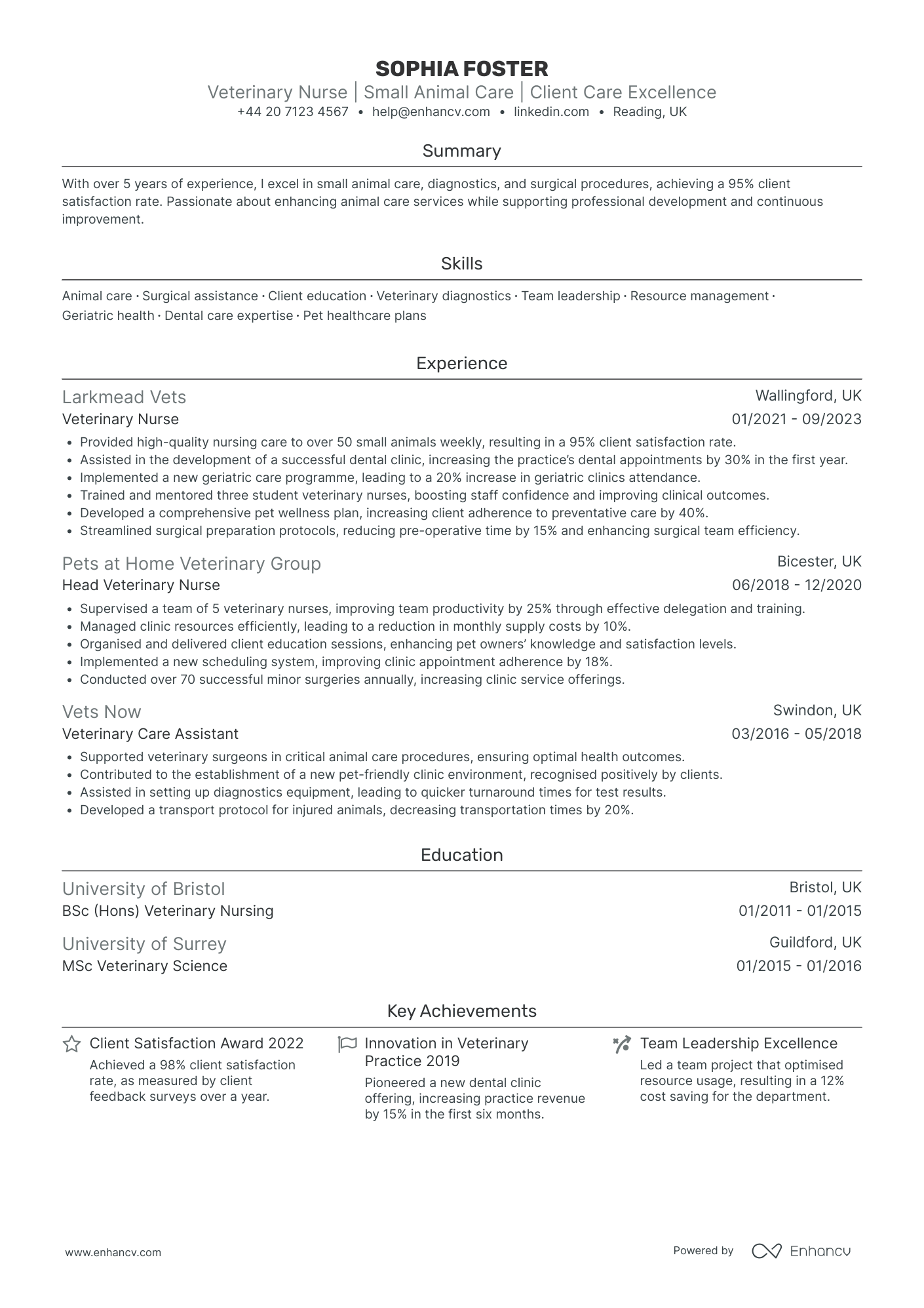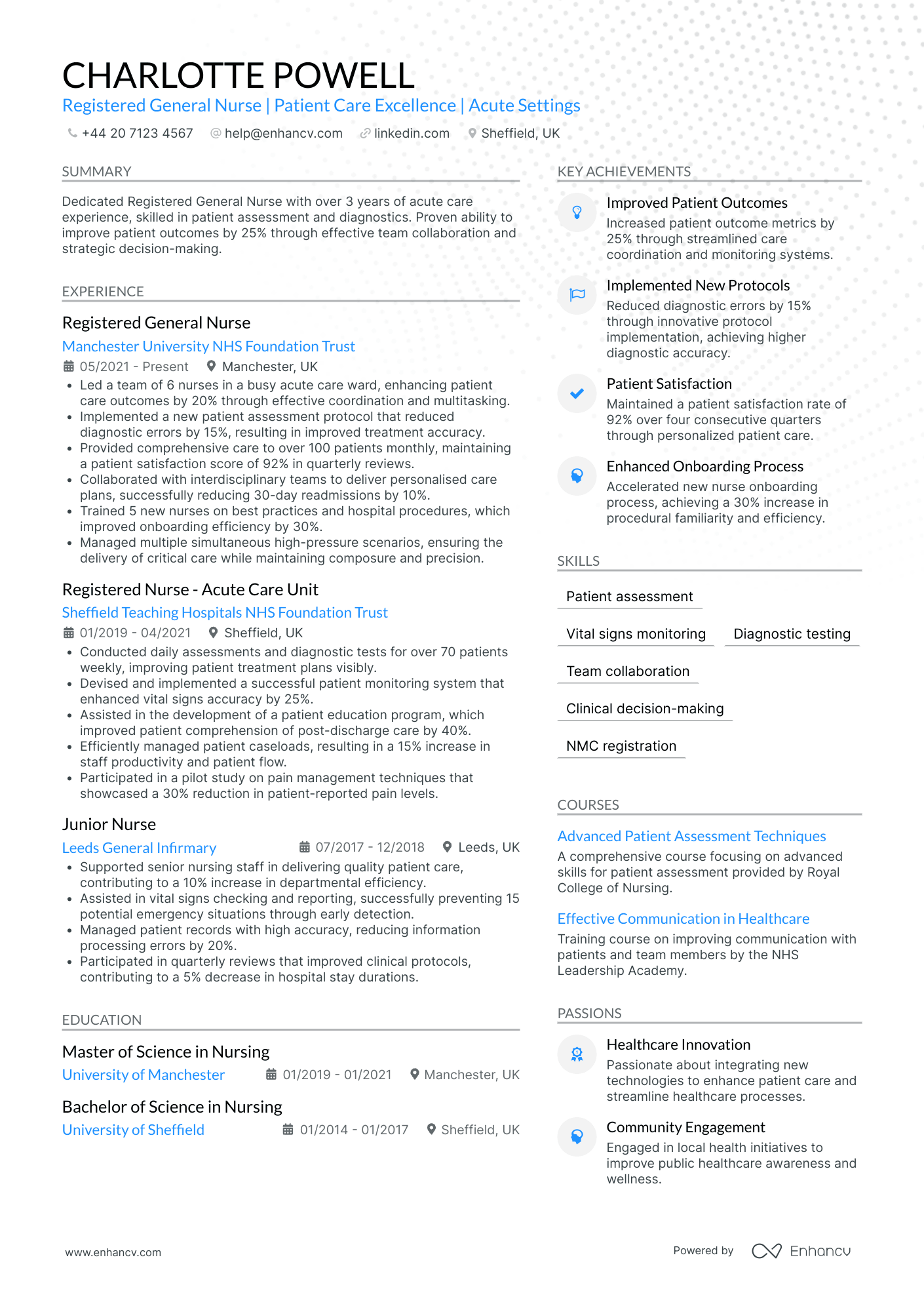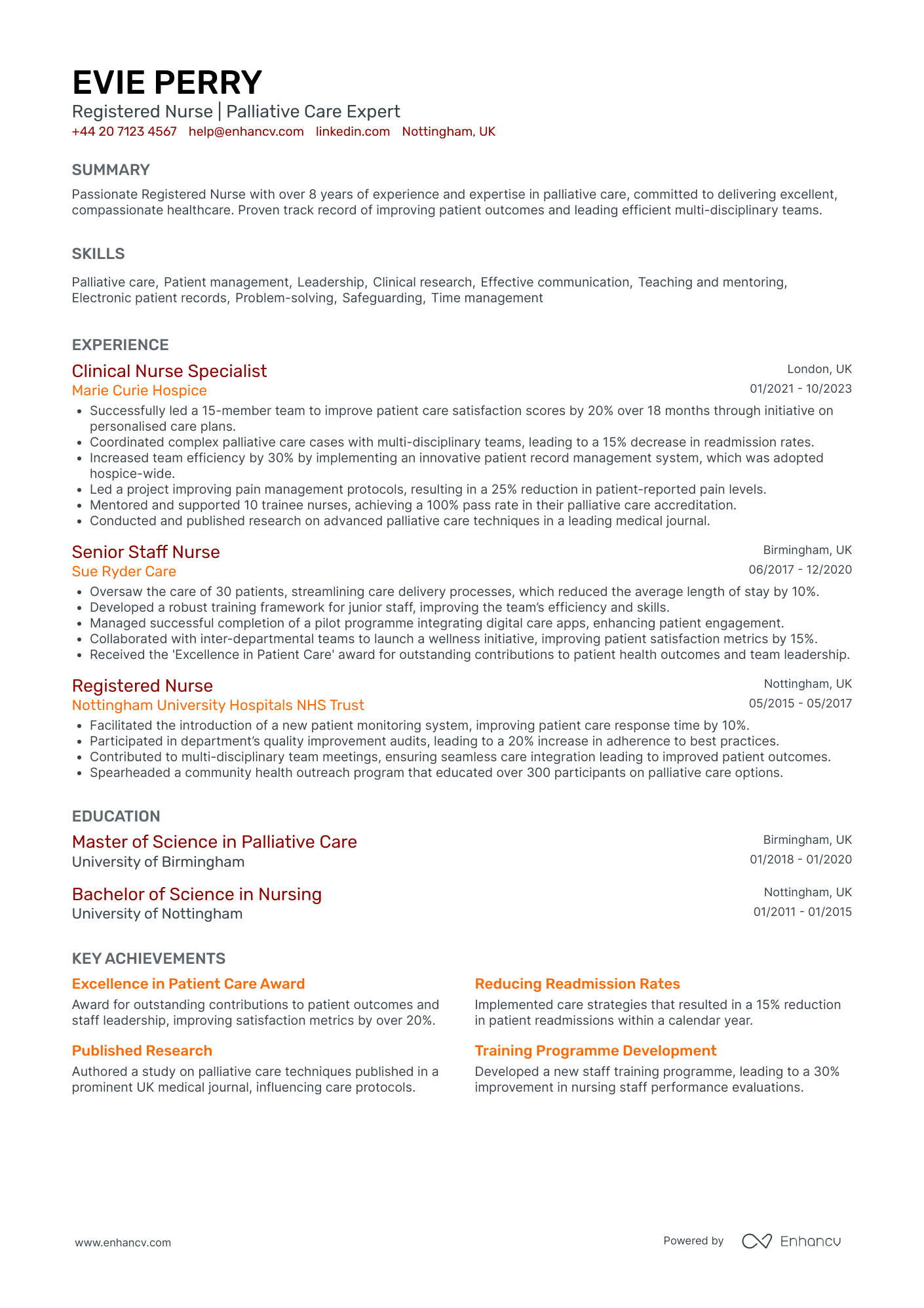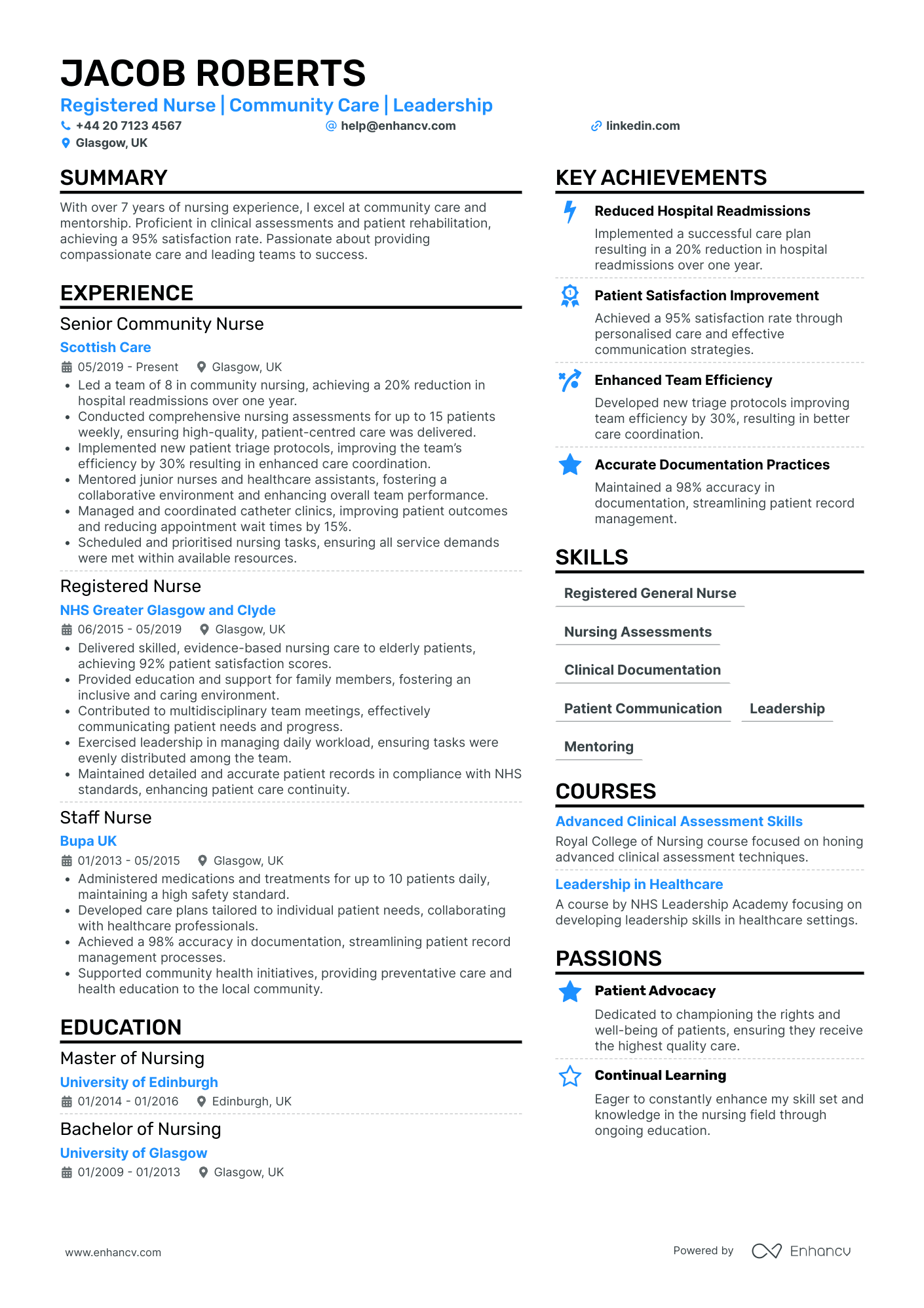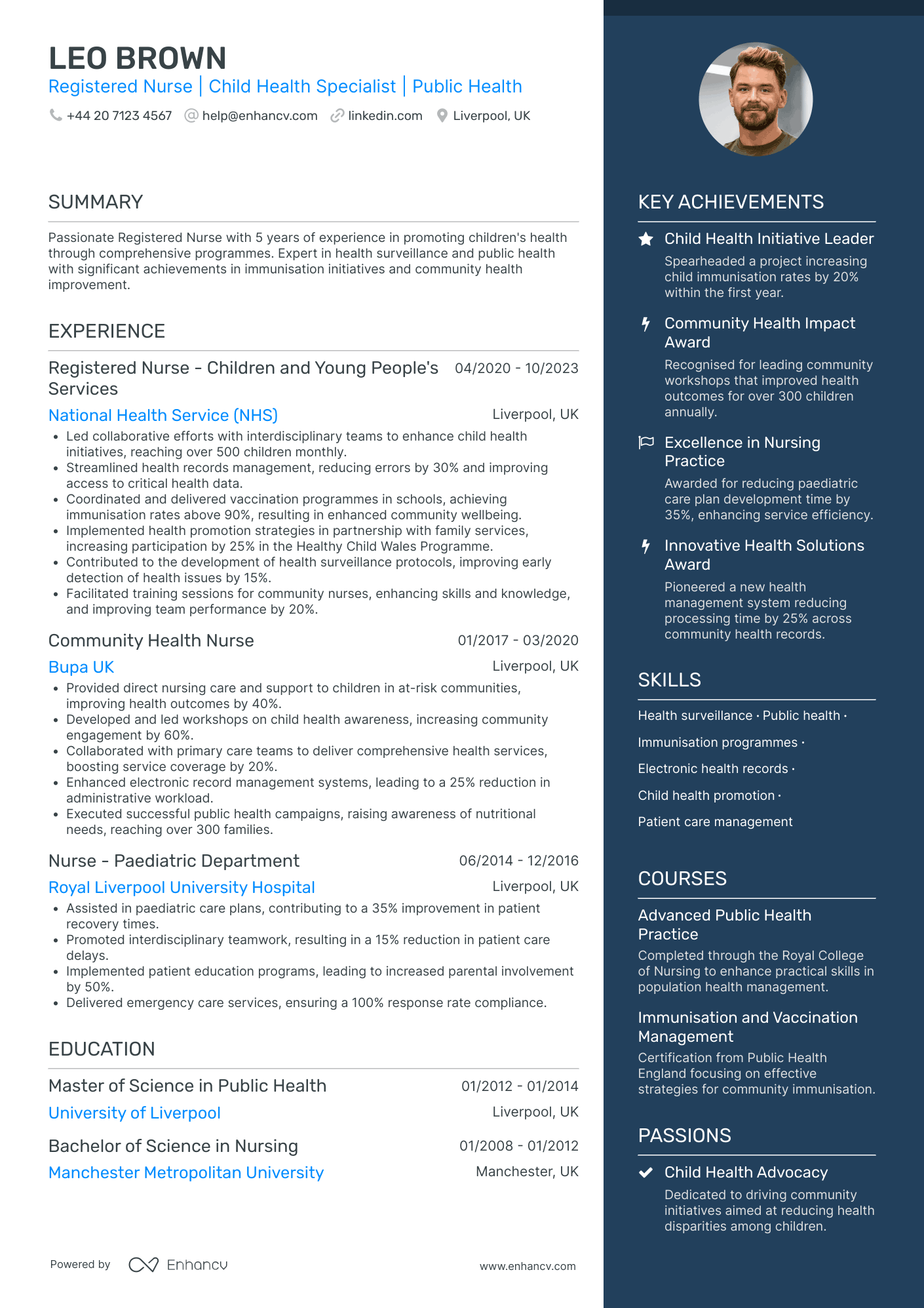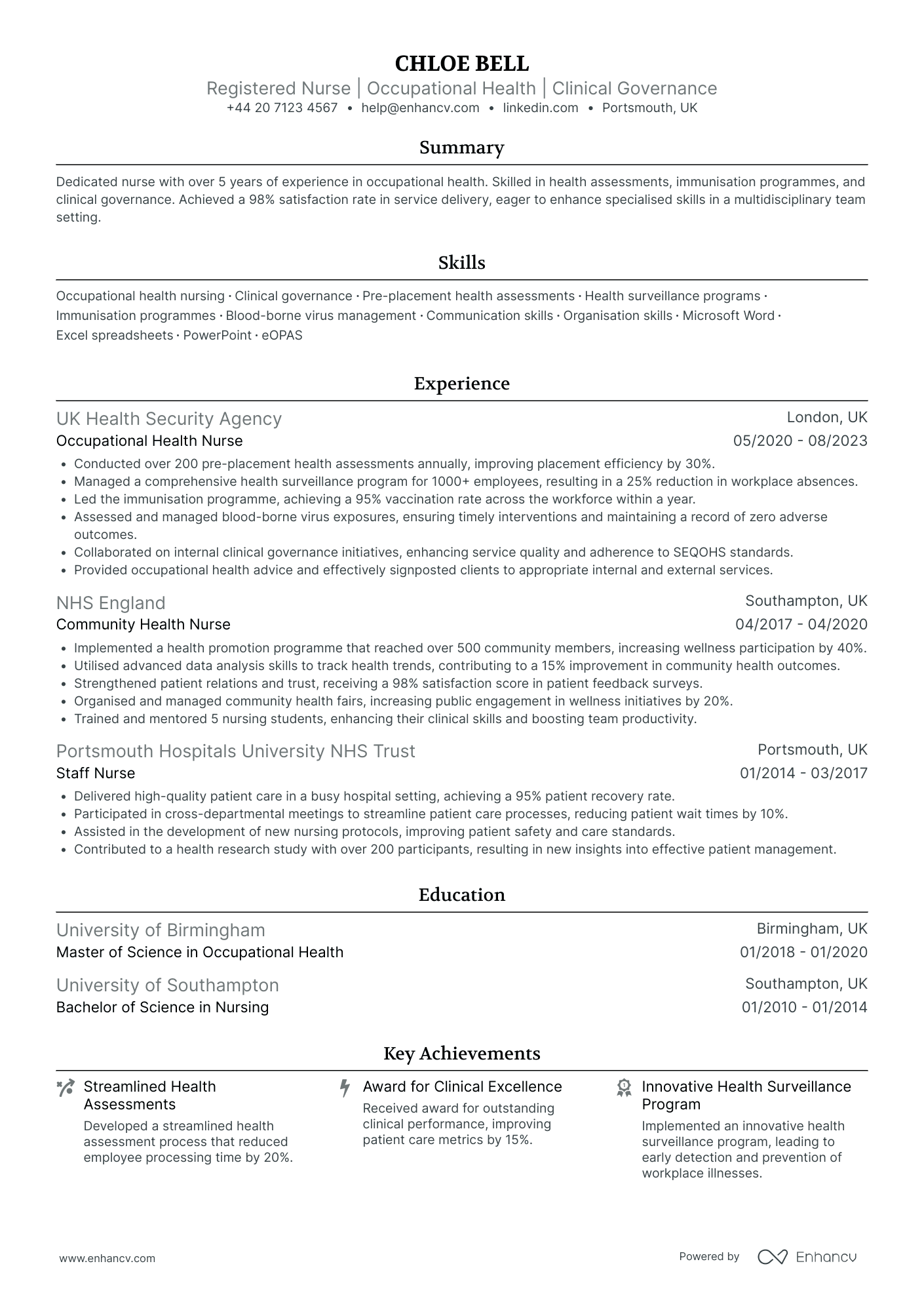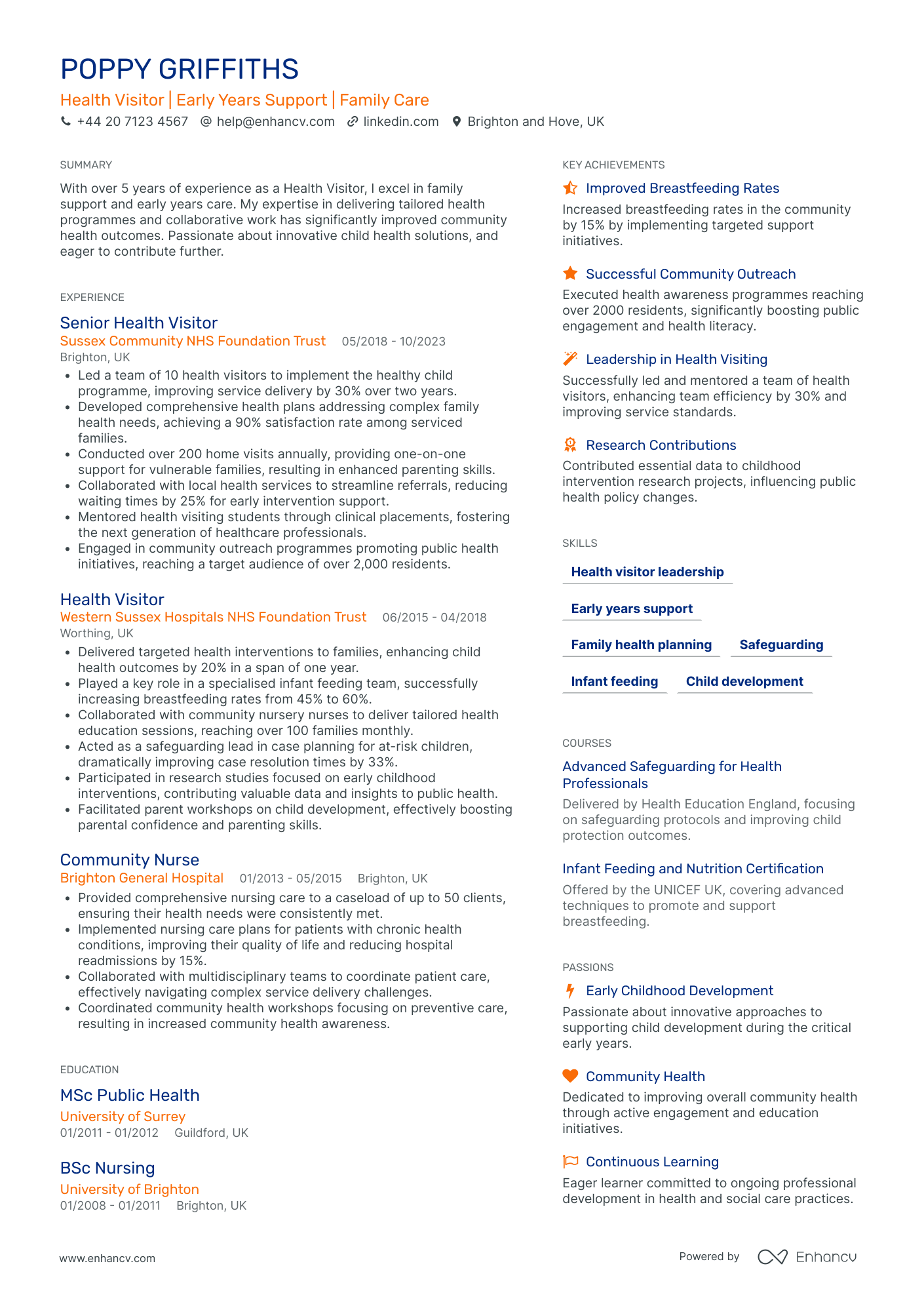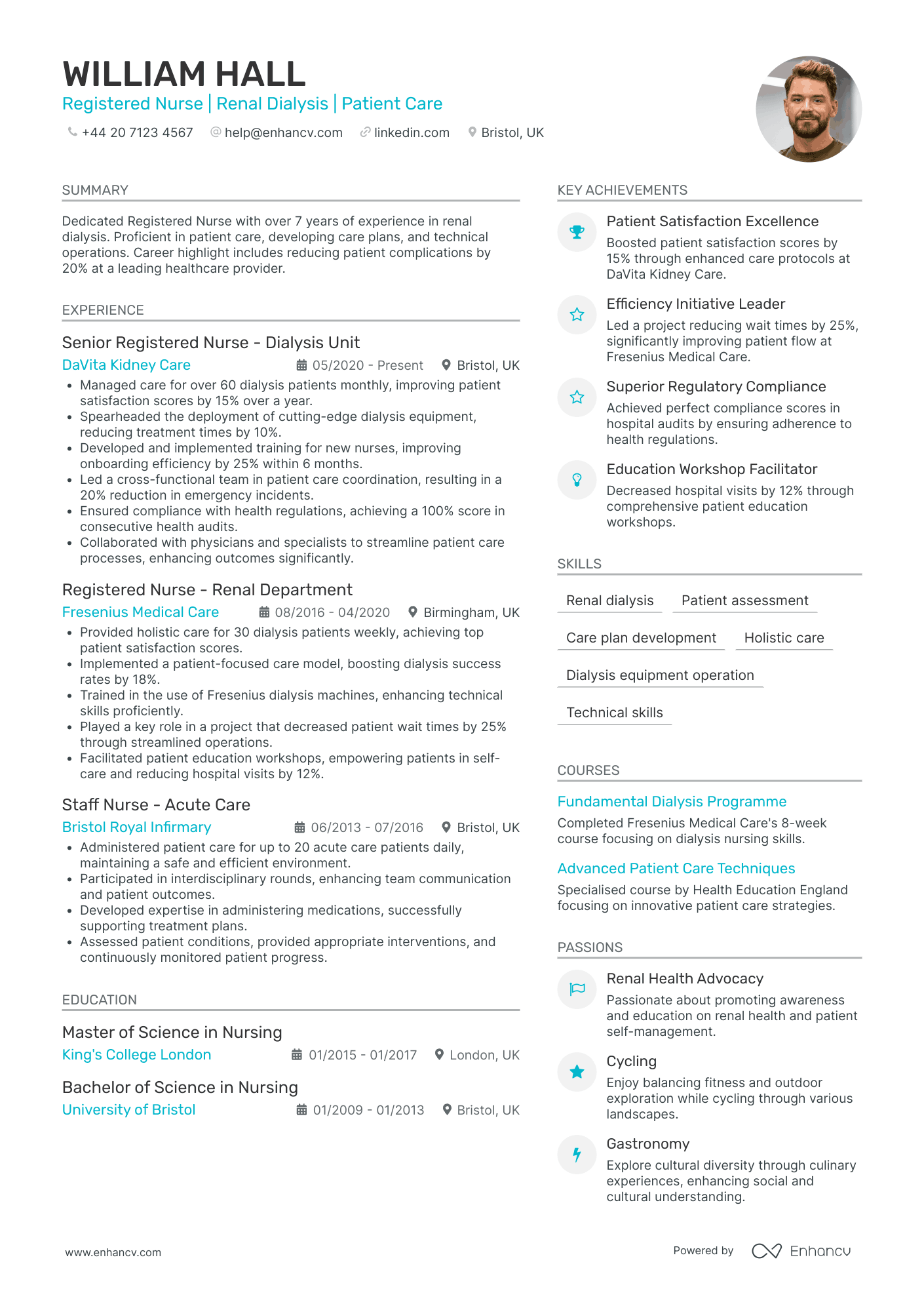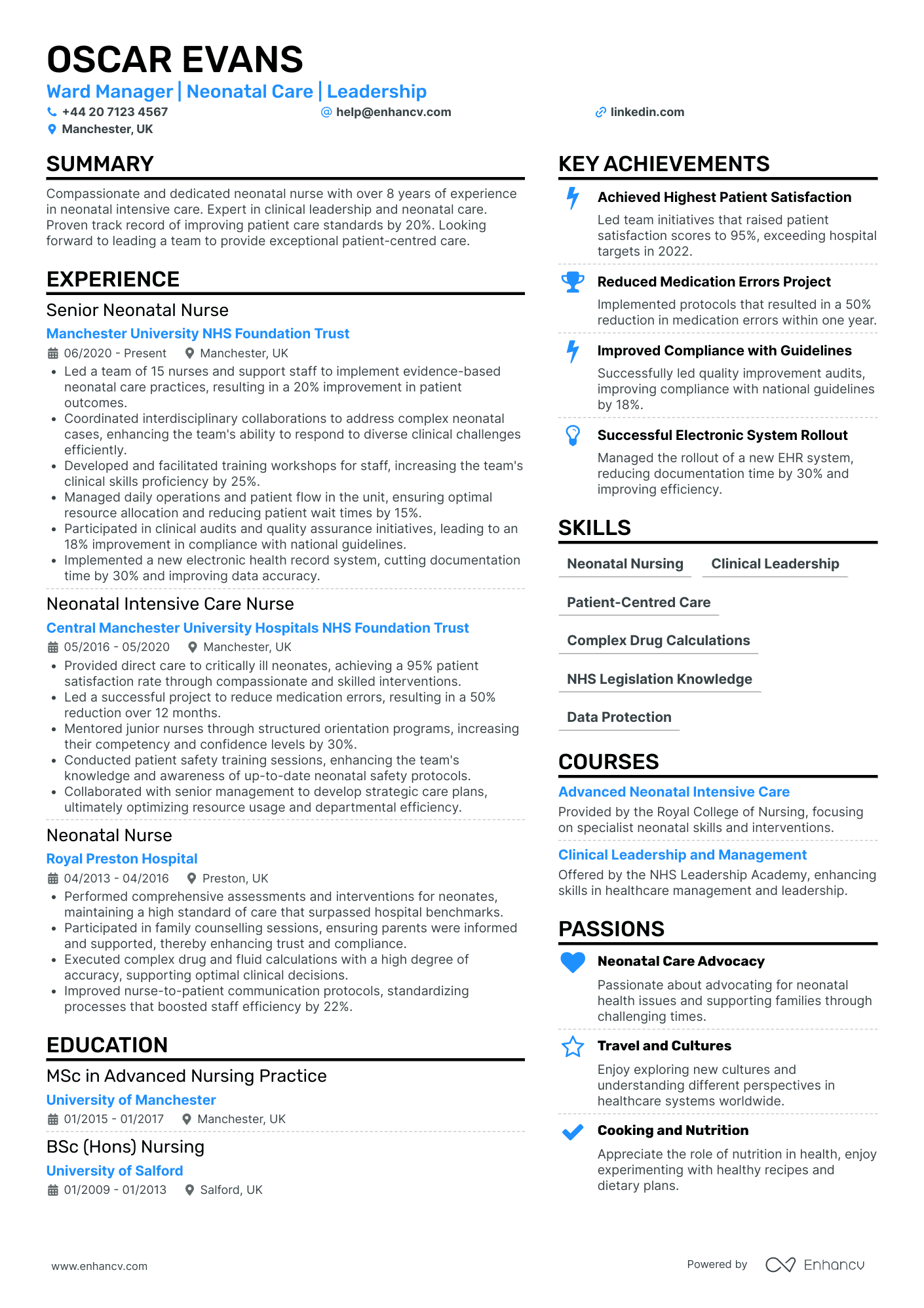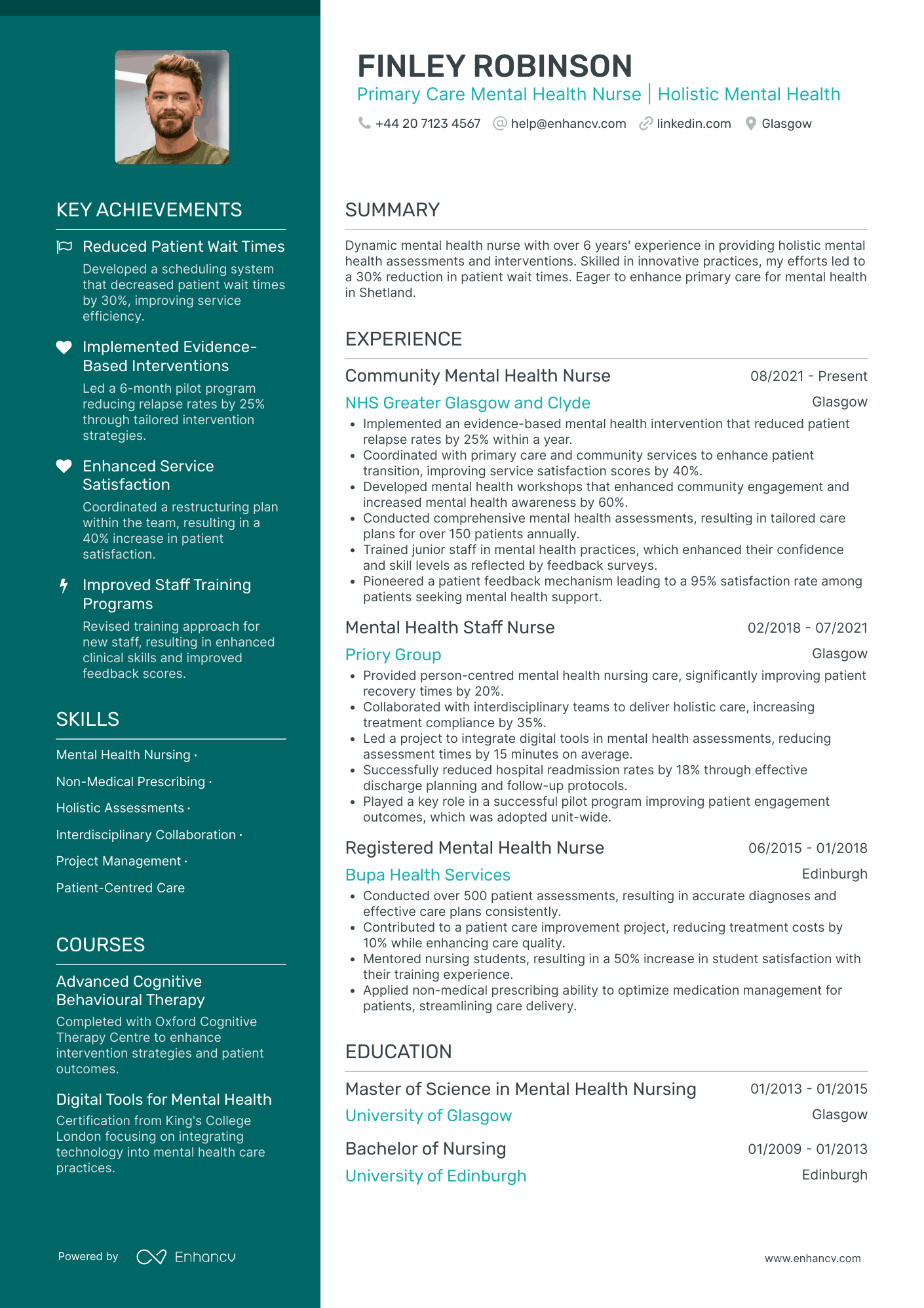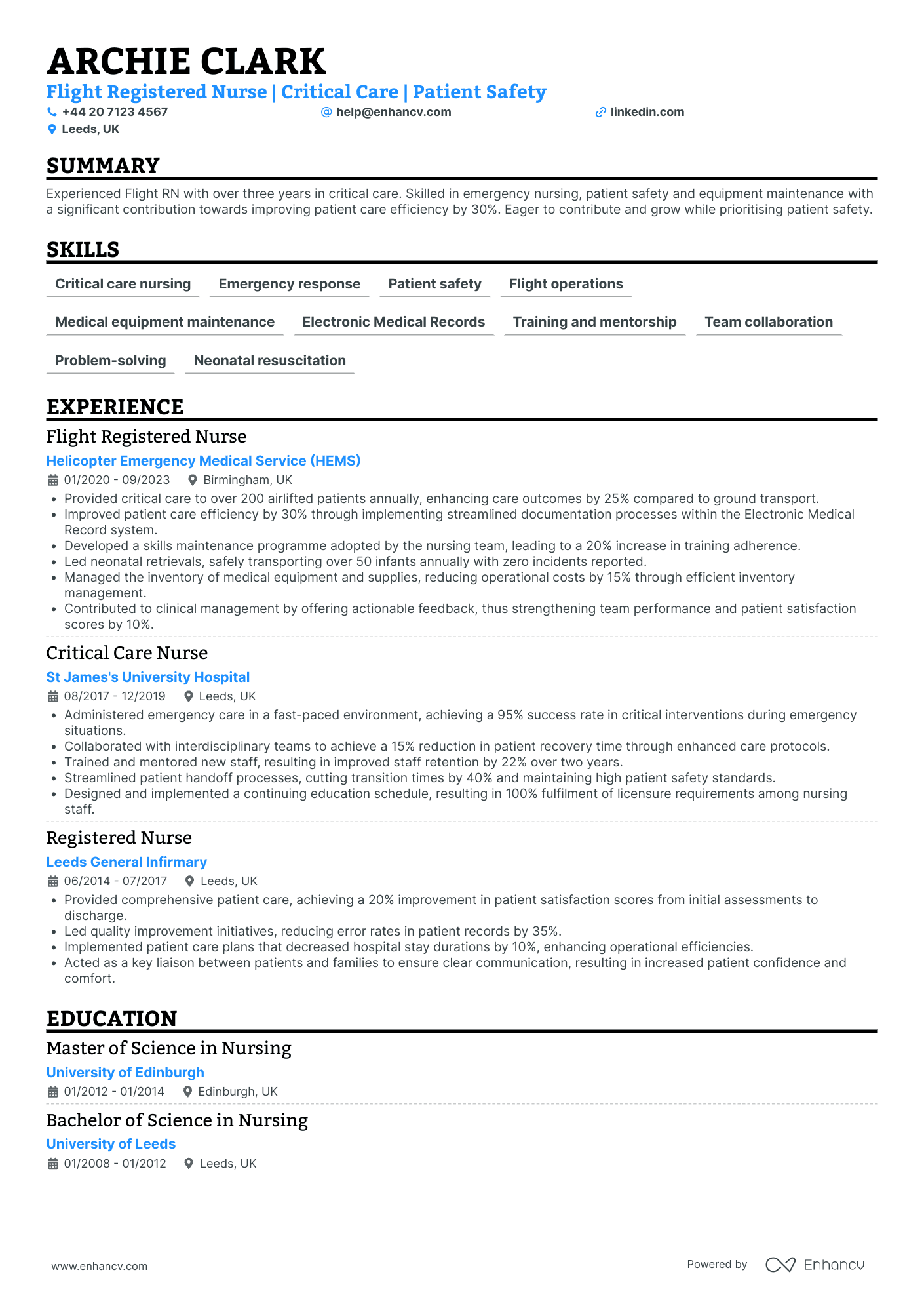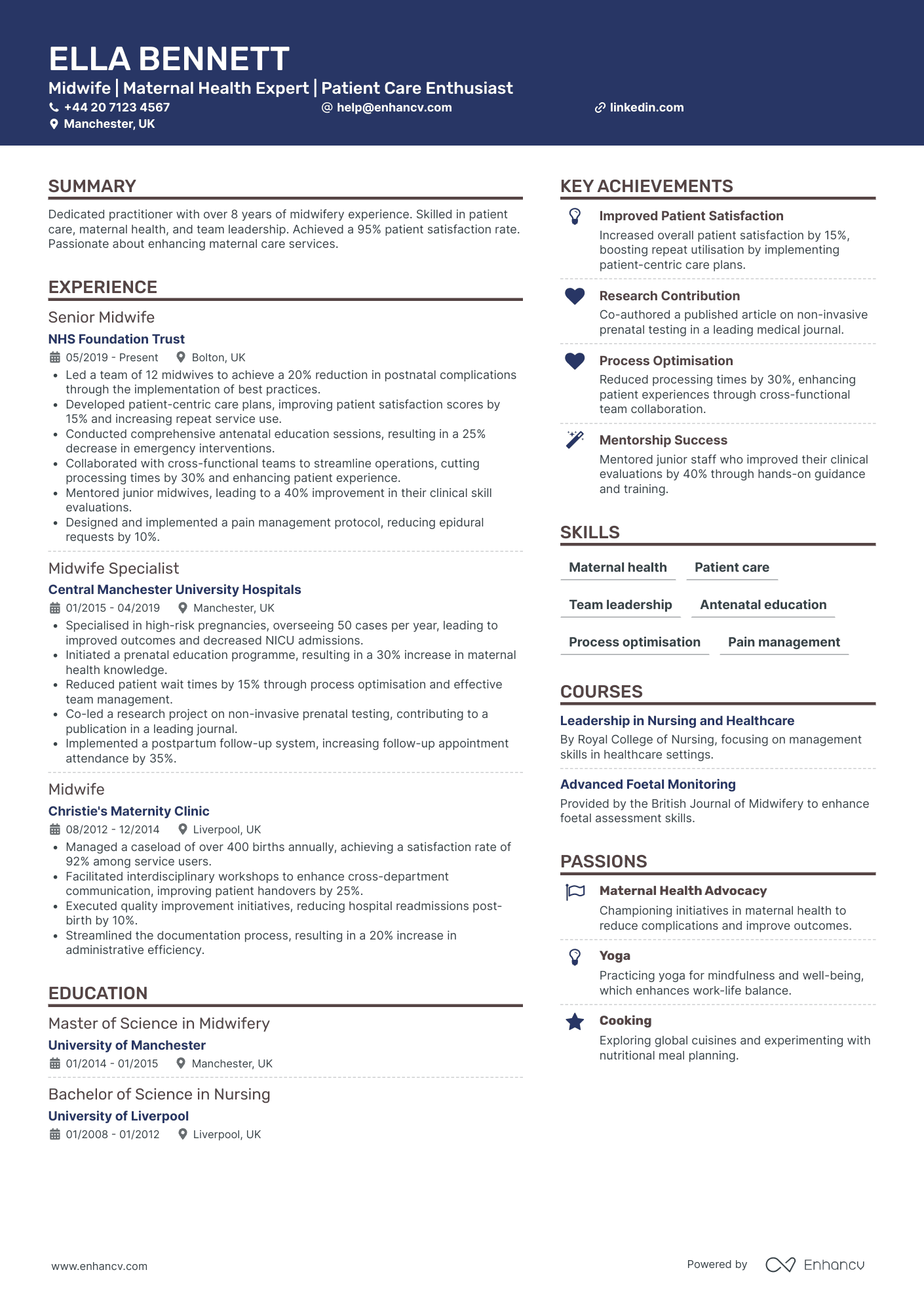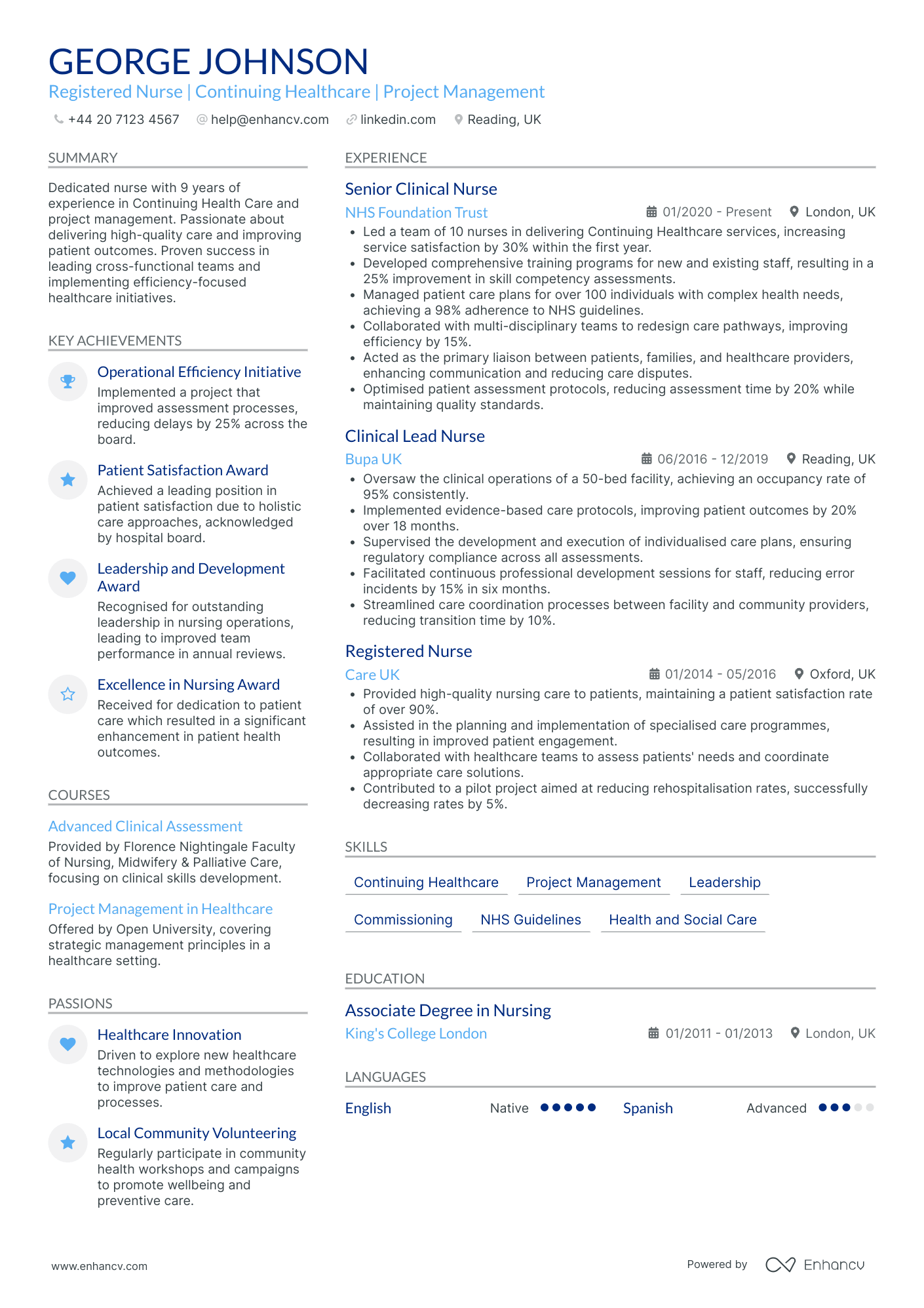Crafting a CV that effectively showcases clinical expertise alongside soft skills is a significant challenge for registered nurses. Our guide offers tailored advice to help you strike the perfect balance, ensuring your CV stands out to potential employers.
- Applying best practices from real-world examples to ensure your profile always meets recruiters' expectations;
- What to include in your work experience section, apart from your past roles and responsibilities?
- Why are both hard and soft skills important for your application?
- How do you need to format your CV to pass the Applicant Tracker Software (ATS) assessment?
If you're writing your CV for a niche registered nurse role, make sure to get some inspiration from professionals:
CV examples for registered nurse
By Role
Registered Nurse - Paediatrics
- Cohesive structure enhancing readability - The CV is exceptionally well-structured, with clearly delineated sections that are easy to follow. Each section flows logically to the next, ensuring the reader can easily understand the candidate’s journey and accomplishments. Conciseness is achieved by prioritizing impactful content and using bullet points to highlight key achievements and responsibilities, making it very reader-friendly.
- Diverse career progression within the healthcare field - Oscar Evans shows a clear trajectory of growth and adaptability in his career, moving from a Staff Nurse to leadership roles as a Band 5 Registered Nurse and a Paramedic Coordinator. This demonstrates not only an upward trajectory in terms of responsibilities and expertise but also a keen ability to adapt to different roles within healthcare, highlighting versatility and dedication to patient care.
- Leadership and teamwork prowess - The CV emphasizes Oscar's leadership and soft skills throughout, noting achievements such as leading teams to improve patient outcomes, developing training programs, and improving team efficiency. These elements underscore his ability to inspire and guide others, effectively manage teams, and promote a culture of continuous improvement within the organizations he serves.
Registered Nurse - Oncology
- Comprehensive and clear structure - The CV is well-organized, starting with a clear header and followed by a succinct summary. Each section is clearly labeled, making it easy for the reader to navigate through Isabella’s professional journey. The bullet points in the experience section contribute to a concise presentation of duties and achievements.
- Demonstrates professional progress and expertise - Isabella’s career trajectory is marked by a series of advanced roles within the NHS, indicating steady growth and increased responsibility. This progression from a Nurse to a Registered Nurse showcases her ability to take on more complex tasks and lead in various healthcare settings, reflecting her competence and dedication.
- Impressive impact through achievements - The CV highlights significant accomplishments with clear business relevance by using quantifiable metrics. Improvements in patient satisfaction and operational efficiency, such as a 30% rise in patient satisfaction scores and a 20% enhancement in patient throughput, illustrate Isabella's ability to deliver tangible improvements in healthcare environments.
Registered Nurse - Emergency Room
- Structured and Concise Presentation - Ava Phillips’ CV is well-organized, starting with a precise header that quickly communicates her name, title, contact information, and key professional attributes. The structured sections, delineated by bold headings, provide clarity and facilitate easy navigation through her professional journey and accomplishments.
- Consistent Career Progression in Veterinary Nursing - The CV demonstrates a clear career trajectory, beginning with a Junior Veterinary Nurse position at Vets4Pets and leading to progressively more responsible roles at Fitzpatrick Referrals and Southern Counties Veterinary Specialists. This progression indicates not just experience but also professional growth and adaptability within the veterinary nursing field.
- Technical Proficiency in Veterinary Nursing - Ava showcases a strong grasp of industry-specific tools and methodologies, such as specialist ward nursing, anaesthesia management, and intensive care. The inclusion of specific veterinary courses further highlights her technical depth and commitment to continuous learning within her field, adding to her expertise.
Registered Nurse - Intensive Care Unit
- Structured Presentation with Clarity and Conciseness - The CV is expertly structured, guiding the reader through sections that seamlessly outline the candidate’s qualifications, professional experience, education, skills, and additional achievements. Each bullet point under the experience section is concise and clearly communicates the key accomplishments and responsibilities, allowing for a quick and effective comprehension of the candidate's capabilities.
- Demonstrates Significant Career Growth and Specialization - Lucas's career trajectory shows a clear path of progression and specialization in critical care nursing. Starting as a Staff Nurse and advancing to roles within intensive care environments, his promotions within different hospitals reflect not only his growth but also an increasing level of trust and responsibility. This trajectory emphasizes a deepening expertise in patient care and intensive care unit (ICU) procedures.
- Highlights Leadership in Patient Safety and Care Improvements - The CV is notable for emphasizing Lucas's leadership skills, particularly in patient safety and communication. His achievements include pioneering initiatives that significantly decreased ICU incidents and improved family satisfaction scores, demonstrating a capacity to lead impactful projects with positive outcomes for both patients and healthcare teams.
Registered Nurse - Operating Room
- Content Presentation and Structure - The CV is well-organized with a clear structure, making it easy to navigate through various sections such as experience, education, skills, and achievements. This allows readers to quickly identify Florence Knight's qualifications and accomplishments, enhancing clarity and conciseness in presenting crucial information.
- Career Trajectory - Florence's career progression is evident as she evolves from a Staff Nurse to a Senior Theatre Nurse within a span of five years. This transition underscores her growth and increasing responsibility, highlighting a steady upward trajectory that aligns with her professional development in surgical nursing environments.
- Impactful Achievements - The CV emphasizes Florence's ability to drive significant improvements in hospital settings. Her achievements, such as initiating projects that reduced infection rates and optimized theatre schedules, underscore her capacity to implement changes that positively affect patient care and operational efficiency, demonstrating business relevance beyond mere numbers.
Registered Nurse - Cardiology
- Excellent Clarity and Structure - The CV is presented in a highly organized manner, with clearly defined sections such as experience, education, skills, and achievements. Each position held is accompanied by specific duties and accomplishments, portraying a concise yet comprehensive career narrative that is easy to follow.
- Impressive Career Growth - William Hall's career trajectory demonstrates significant advancement, progressing from a Clinical Nurse to a Senior Staff Nurse within various reputable hospitals. This path reveals not only professional development but also an increasing level of responsibility and leadership in patient care and hospital operations.
- Innovative Healthcare Initiatives - The CV highlights William's involvement in developing and implementing healthcare initiatives, such as new care policies and infection control measures. These initiatives underscore his technical depth in nursing and commitment to improving clinical outcomes, underscoring his role as a dynamic leader in the healthcare field.
Registered Nurse - Mental Health
- Content Presentation: Clarity and Structure - The CV is well-structured and clearly presented, making it easy for a recruiter to quickly grasp the candidate's qualifications and experience. Each section is succinct, with bullet points used effectively to highlight key achievements and duties, ensuring that the content is not overwhelming.
- Career Trajectory: Consistent Growth - Oscar Evans' career path demonstrates a consistent progression in the mental health field, from Staff Nurse to Mental Health Nurse. This trajectory showcases his growing expertise and enhanced responsibilities over time, highlighting a commitment to advancing his career within the mental health nursing domain.
- Unique Industry-Specific Elements: Evidence-Based Practice - The CV emphasizes unique elements relevant to the mental health sector, such as implementing evidence-based therapeutic interventions and using validated outcome measures. These details underline Oscar's technical depth and commitment to applying research-backed methodologies in his practice, ensuring high-quality patient care.
Registered Nurse - Geriatrics
- Structured and impactful presentation - The CV effectively organizes information into clear sections such as experience, education, skills, achievements, and languages. This systematic approach ensures readability and allows the audience to quickly identify key qualifications such as Sophia's proficiency in veterinary diagnostics and client care excellence.
- Clear career progression - The career trajectory illustrated showcases a steady advancement from a Veterinary Care Assistant to a Head Veterinary Nurse. This upward movement not only highlights Sophia’s growing responsibilities and leadership roles but also indicates her successful navigation of the veterinary field, demonstrating adaptability and dedication to professional growth.
- Innovative contributions to veterinary care - Sophia's achievements in developing new programs, such as a dental clinic and a geriatric care programme, reveal a proactive approach towards enhancing veterinary practice. These initiatives not only improved client satisfaction and clinic attendance but also underline her strategic contribution to business impact and client outreach within her roles.
Registered Nurse - Home Health
- Structured and Concise Presentation - The CV is neatly structured with clear sections that facilitate easy reading and comprehension. Each section is concise, providing essential information without unnecessary details, which helps in maintaining the reader’s attention and ensuring that crucial points stand out.
- Consistent Career Growth - Charlotte Powell's career trajectory clearly demonstrates consistent growth within the nursing field. Starting as a Junior Nurse and advancing to her current role as a Registered General Nurse highlights her professional development and commitment to advancing her skills and responsibilities in acute care settings.
- Impactful Achievements - The CV showcases achievements that highlight significant contributions to patient care and hospital efficiency. For instance, implementing a patient assessment protocol that reduced diagnostic errors by 15% underscores her capability to drive improvements that have a lasting impact on patient outcomes and operational processes.
Registered Nurse - Hospice Care
- Structured and Clear Presentation - The CV is organized with a logical flow that guides the reader through Evie Perry's professional journey. Each section is clearly delineated, allowing for quick reference to her education, experience, and skills, showcasing her expertise in a concise and focused manner.
- Career Growth and Specialization - Evie's career trajectory is marked by a consistent focus on palliative care, demonstrating her specialization in this field. Her progression from a Registered Nurse to a Clinical Nurse Specialist illustrates her growth and increased responsibility, highlighting a dedicated career path with substantial advancements.
- Leadership and Mentoring - Throughout her roles, Evie has demonstrated strong leadership qualities, particularly in her current position where she leads a 15-member team. Her mentoring of trainee nurses and ability to drive improvement projects underscore her capabilities as a leader who can inspire and develop others in the healthcare setting.
Registered Nurse - Rehabilitation
- Clear Career Progression - Jacob’s CV clearly illustrates his professional growth through positions at respected institutions, such as Bupa UK and NHS Greater Glasgow and Clyde, culminating in a leadership role at Scottish Care. This trajectory not only reflects his dedication but also his capability to consistently take on greater responsibilities.
- Leadership and Mentorship Focus - The CV highlights Jacob's strong leadership and mentorship skills through his role in guiding a team of nurses and his initiatives that improve overall team performance. His ability to foster collaboration and enhance efficiency signifies his strength in managing and leading dynamic teams in healthcare settings.
- Impactful Achievements with Business Relevance - Notably, Jacob’s achievements go beyond mere numbers, sharing detailed impacts such as reducing hospital readmissions by 20% and enhancing patient satisfaction. These accomplishments demonstrate a significant, positive influence on both patient care outcomes and operational efficiencies.
Registered Nurse - School Nurse
- Well-Structured Presentation - The CV is organized in a clear and logical structure that effectively outlines the candidate's professional journey. It begins with a concise summary and is followed by distinct sections for experience, education, skills, and achievements, allowing for easy navigation and a comprehensive understanding of the applicant's qualifications.
- Career Growth and Specialization - Leo Brown's career trajectory exhibits a clear progression from a foundational role in paediatric nursing to a specialized focus on community health and child health services. This growth is evident in the transition from hospital-based care to broader public health initiatives, showcasing a commitment to advancing within the healthcare sector.
- Achievements with Community Impact - The CV emphasizes achievements that have significant community impact, particularly in child health. Accomplishments such as increasing immunisation rates and improving health outcomes in at-risk communities highlight the candidate's ability to drive public health benefits, demonstrating relevance to roles focused on societal well-being.
Registered Nurse - Occupational Health
- Structured and Comprehensive Presentation - Chloe Bell's CV is effectively laid out, providing a clear and concise view of her professional journey. Each section is organized for easy readability, with bulleted lists under experiences that highlight key contributions, ensuring that crucial information is quick to grasp.
- Demonstrated Career Growth in Nursing - Starting as a Staff Nurse and evolving into an Occupational Health Nurse, Chloe exhibits a clear and upward career trajectory. This progression not only highlights her growing expertise but also underscores her commitment to progressing within her field while taking on roles with increasing responsibility.
- Distinctive Technical Expertise in Occupational Health - Chloe's proficiency with industry-specific tools like eOPAS and her detailed understanding of health surveillance programs and clinical governance set her apart. Her expertise in SEQOHS standards and immunization strategies demonstrates a depth of knowledge critical to occupational health roles.
Registered Nurse - Community Health
- Structured career progression and leadership - Poppy Griffiths shows a coherent career trajectory with structured growth, moving from a Community Nurse to a Senior Health Visitor within various NHS trusts. Each step signifies increased responsibility and leadership, as reflected in her role leading a team of health visitors to enhance service delivery by 30% in two years.
- Impactful achievements emphasizing community health - Poppy has a history of making substantial impact, particularly shown through her successful efforts in improving breastfeeding rates by 15% and leading community outreach that engaged over 2,000 residents. These achievements are not just quantitative but reflect her ability to foster tangible improvements in community health.
- Comprehensive skill set in public health and early years - The CV presents a wide array of specialized skills pertinent to her role in early year support and family care. Skills such as safeguarding, public health initiatives, and health visitor leadership are complemented by ongoing professional development and contributions to research, underscoring her commitment to her field.
Registered Nurse - Dialysis
- Structured and Concise Content Presentation - The CV is well-structured, making it easy to navigate through different sections such as experience, education, and skills. Each section employs bullet points to condense information, allowing key points to be quickly grasped without overwhelming the reader. The clarity and conciseness effectively communicate the candidate's qualifications and achievements.
- Demonstrates Industry-Specific Expertise in Renal Dialysis - The CV showcases the candidate's depth in renal dialysis through specific roles and responsibilities. The inclusion of technical skills related to dialysis equipment and patient care methodologies underscores their specialized knowledge within the healthcare sector. Such industry-specific elements enhance the CV's appeal to employers in renal departments.
- Leadership and Mentorship Experience - Beyond technical skills, the CV highlights the candidate's leadership capabilities, with experience in leading cross-functional teams and developing training programs for new nurses. These points reflect strong soft skills and the ability to foster an environment of growth and efficiency, which are invaluable in healthcare settings.
Registered Nurse - Neonatal Intensive Care Unit
- Structured and Comprehensive Presentation - The CV is exceptionally well-organized, featuring a clear header and separate sections for summary, experience, education, skills, courses, achievements, languages, and passions. This structure ensures that all relevant information is easily accessible and presents Oscar as a thorough professional.
- Impressive Career Progression and Commitment - Oscar's career trajectory reflects significant growth and dedication to the neonatal care field. Starting as a Neonatal Nurse and advancing to a Senior Neonatal Nurse and Ward Manager, Oscar consistently moved up within reputable NHS Trusts, highlighting leadership growth and professional development.
- Effective Leadership and Soft Skills - The CV highlights Oscar's ability to lead diverse teams, develop training workshops, and manage complex cases. Soft skills such as mentorship, patient-centered care, and expert clinical leadership stand out, demonstrating Oscar's capability to inspire and improve team performance.
Registered Nurse - Travel Nurse
- Clarity and Structure Presentation - The CV is exceptionally well-organized, with each section clearly delineated and labeled. It creates an easy-to-follow narrative from educational background through to career progression, highlighting key accomplishments in a concise manner. The bullet point format in the experience section helps in maintaining clarity and ensuring that the reader can quickly scan through the complexity of the roles covered.
- Career Trajectory and Growth - The CV reflects a well-planned career trajectory, with consistent elevations in responsibility and scope. Starting from a Registered Mental Health Nurse to a Community Mental Health Nurse, there is a clear progression in Finley Robinson's expertise and influence. The candidate demonstrates commitment to the mental health sector, enhancing skills and taking on roles that impact larger-scale outcomes over time.
- Unique Industry Elements and Tools - Utilizing digital tools and adopting evidence-based interventions are standout elements Finley Robinson brings to the table. These unique methodologies demonstrate a willingness to embrace innovative practices, such as integrating digital tools that improved assessment times and applying non-medical prescribing abilities, which underscores a technical depth uncommon in some healthcare resumes.
Registered Nurse - Flight Nurse
- Structured Career Progression - Archie Clark's career trajectory is well-organized, demonstrating a linear progression from a Registered Nurse at Leeds General Infirmary to a Flight Registered Nurse at Helicopter Emergency Medical Service. This growth shows deliberate career choices aligned with advancing into critical care and emergency response, indicating commitment and focused professional development.
- Industry-Specific Proficiency in Flight Nursing - The CV highlights unique elements specific to flight nursing, such as expertise in neonatal retrievals and airborne medical care, enhanced by the Certified Flight Registered Nurse certification. This specialized knowledge underscores an advanced proficiency adaptable to the unique challenges of medical emergencies in flight scenarios.
- Focus on Achievements with Impact - The CV effectively emphasizes business-relevant achievements, illustrating tangible impacts such as a 30% improvement in care efficiency through documentation processes and a 15% reduction in inventory costs. These accomplishments highlight not just skills but also a deep focus on operational efficiency and strategic contributions to healthcare delivery.
Registered Nurse - Midwife
- Comprehensive Career Growth and Ascension - Ella Bennett's CV showcases a robust career trajectory, highlighting her journey from a Midwife to a Senior Midwife. Throughout her career, there is clear evidence of professional growth, as demonstrated by her increasing responsibilities, expertise in high-risk pregnancies, and leadership roles, indicating her ability to adapt and thrive in dynamic healthcare environments.
- Impactful Achievements and Industry Contributions - The CV effectively underscores Bennett’s tangible contributions to maternal healthcare through her achievements. Notably, the implementation of patient-centric care plans and a pain management protocol contributed significantly to enhancing patient experiences and satisfaction. Her co-authorship on a publication regarding non-invasive prenatal testing demonstrates industry-specific expertise and intellectual contribution.
- Structured and Concise Information Presentation - This CV achieves clarity and conciseness by presenting information in well-organized sections. Each part, from education to skills, is structured to communicate essential details effectively. The use of bullets and headings allows for quick consumption of critical information, making it easy for recruiters to identify key qualifications and accomplishments relevant to the role of a maternal health expert.
Registered Nurse - Clinical Nurse Specialist
- Logical structure and clarity - The CV is well-organized, presenting information in clear sections that are easy to navigate. Each section, from experience to education, is concise yet comprehensive, allowing the reader to quickly understand George Johnson's qualifications and expertise. The use of bullet points ensures that key achievements and responsibilities are highlighted effectively.
- Robust career progression - George's career trajectory showcases a significant growth path, moving from a Registered Nurse to a Senior Clinical Nurse. This progression indicates not only an accumulation of experience and expertise but also a recognition of leadership capabilities and increased responsibilities, particularly in project management and team leadership within healthcare settings.
- Industry-specific leadership and impact - George Johnson's CV highlights valuable contributions to healthcare through unique initiatives such as improving assessment processes and developing training programs. These achievements reflect a deep understanding of industry-specific challenges and the ability to drive significant improvements, enhancing patient satisfaction and operational efficiency in healthcare environments.
How to ensure your profile stands out with your registered nurse CV format
It's sort of a Catch 22. You want your registered nurse CV to stand out amongst a pile of candidate profiles, yet you don't want it to be too over the top that it's unreadable. Where is the perfect balance between your CV format simple, while using it to shift the focus to what matters most. That is - your expertise. When creating your registered nurse CV:
- list your experience in the reverse chronological order - starting with your latest roles;
- include a header with your professional contact information and - optionally - your photograph;
- organise vital and relevant CV sections - e.g. your experience, skills, summary/ objective, education - closer to the top;
- use no more than two pages to illustrate your professional expertise;
- format your information using plenty of white space and standard (2.54 cm) margins, with colours to accent key information.
Once you've completed your information, export your registered nurse CV in PDF, as this format is more likely to stay intact when read by the Applicant Tracker System or the ATS. A few words of advice about the ATS - or the software used to assess your profile:
- Generic fonts, e.g. Arial and Times New Roman, are ATS-compliant, yet many candidates stick with these safe choices. Ensure your CV stands out by using a more modern, and simple, fonts like Lato, Exo 2, Volkhov;
- All serif and sans-serif fonts are ATS-friendly. Avoid the likes of fancy decorative or script typography, as this may render your information to be illegible;
- Both single- and double-column formatted CVs could be assessed by the ATS;
- Integrating simple infographics, icons, and charts across your CV won't hurt your chances during the ATS assessment.

PRO TIP
Incorporate a touch of colour in headers or section breaks, but keep it professional and ensure it doesn’t detract from readability, especially in more conservative industries.

The top sections on a registered nurse CV
- Professional Registration states the nurse's current licensing status, essential for ensuring legal qualification for the role.
- Work Experience details the nurse's clinical background and specialties, highlighting practical skills and expertise.
- Clinical Skills and Procedures lists specific medical competencies, showcasing the nurse's hands-on experience.
- Education and Training showcases academic background and continued professional development critical in nursing.
- Awards and Honours reflect acknowledgment of the nurse's exceptional work and contributions to healthcare.

What recruiters value on your CV:
- Highlight your clinical experience by detailing the types of wards or units you've worked on, emphasizing any speciality areas such as A&E, ICU, or paediatrics, to demonstrate the breadth and depth of your nursing skills.
- Include any additional qualifications or professional development courses that are relevant to nursing, such as Advanced Cardiac Life Support (ACLS) or paediatric nursing certifications, to showcase your commitment to ongoing learning.
- Emphasise your proficiency with electronic health record (EHR) systems and any nursing-specific technology, as digital competence is increasingly important for modern healthcare environments.
- Mention your capability in handling complex patient care and your experience with care plans, multidisciplinary team coordination, and patient advocacy, to show your comprehensive approach to patient health.
- Document your soft skills, such as communication, empathy, and teamwork, by using examples of patient interactions, collaboration with healthcare professionals, or situations where these skills have been critical, as these are invaluable in nursing roles.
Recommended reads:
Our checklist for the must-have information in your registered nurse CV header
Right at the very top of your registered nurse CV is where you'd find the header section or the space for your contact details, headline, and professional photo. Wondering how to present your the name of the city you live in and the country abbreviation as your address;
- are tailored to the role you're applying for by integrating key job skills and requirements;
- showcase what your unique value is, most often in the form of your most noteworthy accomplishment;
- select your relevant qualifications, skills, or current role to pass the Applicant Tracker System (ATS) assessment. Still not sure how to write your CV headline? Our examples below showcase best practices on creating effective headlines:

Examples of good CV headlines for registered nurse:
- Registered Nurse | Critical Care Specialist | BSc Nursing | 5+ Years of ICU Expertise
- Paediatric Nurse | Child Health Advocate | RSCN | Passion for Early Years Development | 3 Years' Experience
- Theatre Nurse | Operating Room Proficiency | Mentor in Surgical Procedures | 8 Years of Dedicated Service
- Community Health Nurse | Public Health Promotion | NMC Certified | 10 Years in Community Outreach
- Oncology Nursing Practitioner | Cancer Care Expert | Chemotherapy Certification | Compassionate Care | 7+ Years Experience
- Neonatal Intensive Care Nurse | Premature & Newborn Specialist | Advanced Resuscitation | 12 Years of Nurturing Lives
Your registered nurse CV introduction: selecting between a summary and an objective
registered nurse candidates often wonder how to start writing their resumes. More specifically, how exactly can they use their opening statements to build a connection with recruiters, showcase their relevant skills, and spotlight job alignment. A tricky situation, we know. When crafting you registered nurse CV select between:
- A summary - to show an overview of your career so far, including your most significant achievements.
- An objective - to show a conscise overview of your career dreams and aspirations.
Find out more examples and ultimately, decide which type of opening statement will fit your profile in the next section of our guide:

CV summaries for a registered nurse job:
Narrating the details of your registered nurse CV experience section
Perhaps you've heard it time and time again, but, how you present your experience is what matters the most. Your CV experience section - that details your work history alongside your accomplishments - is the space to spotlight your unqiue expertise and talents. So, avoid solely listing your responsibilities, but instead:
- adverts' keywords and integrate those in your experience section;
- Use your CV to detail how you've been promoted in the past by including experience in the reverse chronological order.
Before you start writing your registered nurse CV experience section, dive into some industry-leading examples on how to structure your bullets.

Best practices for your CV's work experience section
- Provided high-quality patient care as a registered nurse in a 30-bed general medical ward, adeptly handling critical care, wound dressing, and administering medication following strict protocols.
- Efficiently managed caseloads of up to 15 patients per shift, ensuring detailed patient assessments and the development of personalised care plans.
- Demonstrated strong communication skills by effectively collaborating with multidisciplinary teams, including doctors, pharmacists, and physiotherapists, to optimise patient outcomes.
- Utilised advanced clinical skills to perform life-saving procedures such as CPR and defibrillation, with a record of quick response during emergencies.
- Maintained meticulous records in patient charts with a keen eye for detail, ensuring the accuracy of all medical information and adherence to GDPR.
- Regularly conducted patient and family education, providing clear explanations about health conditions, treatments, and home care instructions.
- Supervised and mentored junior nurses and nursing students, offering guidance on best practices while fostering a supportive learning environment.
- Successfully implemented infection control protocols, significantly reducing the incidence of hospital-acquired infections within the ward.
- Demonstrated commitment to a professional development by attending workshops on palliative care, acute pain management, and advanced cardiac life support (ACLS).
- Coordinated care for a diverse patient population of 30-40 patients per day in a high-paced urban hospital, achieving a 95% patient satisfaction rating
- Mentored a team of 10 junior nurses, improving team efficiency by 20% through the development of a streamlined triage process
- Implemented a new electronic health record system, reducing medication errors by 40% and ensuring more accurate patient records
- Supervised 5 other registered nurses and 10 nurse assistants, providing leadership and managing scheduling to maintain optimal staffing levels
- Designed an initiative to address patient falls, which resulted in a 30% reduction in falls over a six-month period
- Led a cross-functional team to develop patient education materials, increasing patients’ adherence to treatment plans by 25%
- Managed critical care for post-operative patients in a 15-bed ICU, improving recovery times by 10% through personalized care plans
- Served as a member of the hospital’s quality improvement committee, identifying and addressing areas for improvement in patient care delivery
- Pioneered a pain management protocol for post-surgical patients that decreased the use of opioids by 35%
- Conducted comprehensive patient assessments and developed care plans for an average of 20 patients daily in a medical-surgical unit
- Collaborated with a multidisciplinary team to manage patient cases, resulting in a decrease in readmission rates by 15%
- Facilitated community health workshops, reaching over 200 individuals and leading to an increase in community health awareness
- Delivered high-quality patient care to up to 25 mothers and newborns daily on the maternity ward, with zero incidents of mother-to-child infection
- Trained 20 nursing staff on lactation best practices, enhancing the maternity unit's support for breastfeeding mothers
- Assisted in the development of a peer review program which improved the career development pathway for the nursing staff
- Played a key role in achieving Magnet Recognition for nursing excellence by leading a quality initiative focused on patient-centered care
- Spearheaded a vaccination campaign during flu season that reached 4,000 patients and staff, leading to a 60% reduction in flu cases within the facility
- Coordinated with a team to integrate telehealth services, increasing remote patient consultations by 50% and enhancing access to care
- Acted as the primary nursing contact for oncology patients, managing care for up to 15 patients daily and improving patient comfort during treatments
- Introduced a compassionate communication program for the oncology department, resulting in improved patient-nurse rapport
- Organized monthly interdisciplinary case conferences to optimize patient care plans, reducing the length of hospital stays by an average of two days for oncology patients
- Provided emergency medical care in a 50-bed ER, successfully reducing average patient wait times by 15% through process optimization
- Implemented a protocol for rapid response to critical care patients, which helped improve patient outcomes by ensuring timely interventions
- Facilitated training sessions on emergency care procedures for 30 new nursing staff, significantly enhancing the unit's service delivery capabilities
- Managed care for children with various acute and chronic conditions in a 20-bed pediatric unit, achieving a 98% patient and family satisfaction score
- Collaborated on a research project studying the impact of play therapy on hospital stays, which led to a hospital-wide implementation of the program
- Developed and led a series of community outreach programs focused on preventative care for children, reaching over 500 families annually
- Managed pre- and post-operative care for patients undergoing cardiovascular surgeries in a specialized 12-bed unit, recording a 99% rate of successful recoveries
- Participant in a landmark clinical trial for a new heart failure medication, contributing to research that resulted in FDA approval
- Established a monthly support group for patients dealing with heart diseases, enhancing their coping mechanisms and post-operative success
Writing your CV without professional experience for your first job or when switching industries
There comes a day, when applying for a job, you happen to have no relevant experience, whatsoever. Yet, you're keen on putting your name in the hat. What should you do? Candidates who part-time experience , internships, and volunteer work.
Recommended reads:

PRO TIP
Include examples of how you adapted to new tools, environments, or work cultures, showing your flexibility.
Mix and match hard and soft skills across your registered nurse CV
Your skill set play an equally valid role as your experience to your application. That is because recruiters are looking for both:
- hard skills or your aptitude in applying particular technologies
- soft skills or your ability to work in a team using your personal skills, e.g. leadership, time management, etc.
Are you wondering how you should include both hard and soft skills across your registered nurse CV? Use the:
- skills section to list between ten and twelve technologies that are part of the job requirement (and that you're capable to use);
- strengths and achievements section to detail how you've used particular hard and soft skills that led to great results for you at work;
- summary or objective to spotlight up to three skills that are crucial for the role and how they've helped you optimise your work processes.
One final note - when writing about the skills you have, make sure to match them exactly as they are written in the job ad. Take this precautionary measure to ensure your CV passes the Applicant Tracker System (ATS) assessment.
Top skills for your registered nurse CV:
Patient care
Clinical knowledge
Administering medication
Advanced Cardiac Life Support (ACLS)
Basic Life Support (BLS)
Wound dressing
Emergency care
Patient assessment
Medical record keeping
Sterilisation techniques
Communication
Empathy
Teamwork
Problem-solving
Time management
Stress management
Adaptability
Attention to detail
Critical thinking
Professionalism

PRO TIP
If there's a noticeable gap in your skillset for the role you're applying for, mention any steps you're taking to acquire these skills, such as online courses or self-study.
Your university degree and certificates: an integral part of your registered nurse CV
Let's take you back to your uni days and decide what information will be relevant for your registered nurse CV. Once more, when discussing your higher education, select only information that is pertinent to the job (e.g. degrees and projects in the same industry, etc.). Ultimately, you should:
- List only your higher education degrees, alongside start and graduation dates, and the university name;
- Include that you obtained a first degree for diplomas that are relevant to the role, and you believe will impress recruiters;
- Showcase relevant coursework, projects, or publications, if you happen to have less experience or will need to fill in gaps in your professional history.

PRO TIP
Focus on describing skills in the context of the outcomes they’ve helped you achieve, linking them directly to tangible results or successes in your career.
Recommended reads:
Key takeaways
Your successful job application depends on how you well you have aligned your registered nurse CV to the job description and portrayed your best skills and traits. Make sure to:
- Select your CV format, so that it ensures your experience is easy to read and understand;
- Include your professional contact details and a link to your portfolio, so that recruiters can easily get in touch with you and preview your work;
- Write a CV summary if you happen to have more relevant professional experience. Meanwhile, use the objective to showcase your career dreams and ambitions;
- In your CV experience section bullets, back up your individual skills and responsibilities with tangible achievements;
- Have a healthy balance between hard and soft skills to answer the job requirements and hint at your unique professional value.
